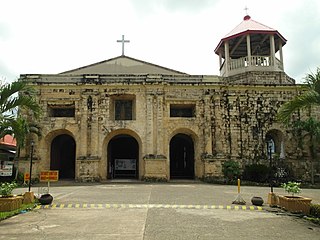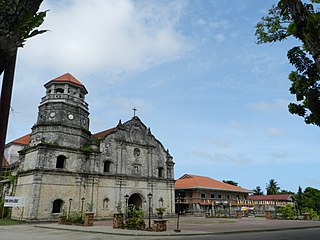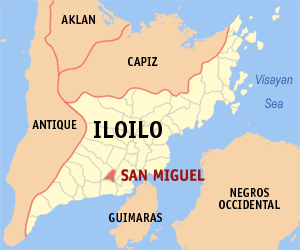
Western Visayas is an administrative region in the Philippines, numerically designated as Region VI. It consists of six provinces and two highly urbanized cities. The regional center is Iloilo City. The region is dominated by the native speakers of four Visayan languages: Hiligaynon, Kinaray-a, Aklanon and Capiznon. The land area of the region is 20,794.18 km2 (8,028.68 sq mi), and with a population of 7,954,723 inhabitants, it is the second most populous region in the Visayas after Central Visayas.

Trinidad, officially the Municipality of Trinidad, is a 3rd class municipality in the province of Bohol, Philippines. According to the 2020 census, it has a population of 35,119 people.

Cuartero, officially the Municipality of Cuartero, is a 4th class municipality in the province of Capiz, Philippines. According to the 2020 census, it has a population of 27,993 people.

Dao, officially the Municipality of Dao, is a 4th class municipality in the province of Capiz, Philippines. According to the 2020 census, it has a population of 33,842 people.

Dumalag, officially the Municipality of Dumalag, is a 4th class municipality in the province of Capiz, Philippines. According to the 2020 census, it has a population of 30,098 people.

Dumarao, officially the Municipality of Dumarao, is a 2nd class municipality in the province of Capiz, Philippines. According to the 2020 census, it has a population of 49,506 people.

Ivisan, officially the Municipality of Ivisan, is a 4th class municipality in the province of Capiz, Philippines. According to the 2020 census, it has a population of 31,278 people.

Jamindan, officially the Municipality of Jamindan, is a 2nd class municipality in the province of Capiz, Philippines. According to the 2020 census, it has a population of 38,670 people.

Ma-ayon, officially the Municipality of Ma-ayon, is a 3rd class municipality in the province of Capiz, Philippines. According to the 2020 census, it has a population of 41,226 people. It has a total land area of 142.32 km2 (54.95).

Mambusao, officially the Municipality of Mambusao, is a 3rd class municipality in the province of Capiz, Philippines. According to the 2020 census, it has a population of 40,690 people.

Panay, officially the Municipality of Panay, is a 3rd class municipality in the province of Capiz, Philippines. According to the 2020 census, it has a population of 48,890 people.

Panitan, officially the Municipality of Panitan, is a 3rd class municipality in the province of Capiz, Philippines. According to the 2020 census, it has a population of 42,565 people.

Pontevedra, officially the Municipality of Pontevedra, is a 3rd class municipality in the province of Capiz, Philippines. According to the 2020 census, it has a population of 49,725 people.

President Roxas, officially the Municipality of President Roxas, is a 4th class municipality in the province of Capiz, Philippines. According to the 2020 census, it has a population of 31,269 people.

Sapian, officially the Municipality of Sapian, and sometimes spelled Sapi-an, is a 4th class municipality in the province of Capiz, Philippines. According to the 2020 census, it has a population of 26,697 people. It is 27 kilometres (17 mi) from Roxas City, the provincial capital.

Sigma, officially the Municipality of Sigma, is a 4th class municipality in the province of Capiz, Philippines. According to the 2020 census, it has a population of 31,688 people.

Tapaz, officially the Municipality of Tapaz, is a 1st class municipality in the province of Capiz, Philippines. According to the 2020 census, it has a population of 54,423 people.

Basey, officially the Municipality of Basey, is a 1st class municipality in the province of Samar, Philippines. According to the 2020 census, it has a population of 56,685 people.

Catubig, officially the Municipality of Catubig, is a 3rd class municipality in the province of Northern Samar, Philippines. According to the 2020 census, it has a population of 32,174 people.

San Miguel, officially the Municipality of San Miguel, is a 4th class municipality in the province of Iloilo, Philippines. According to the 2020 census, it has a population of 30,115 people.























